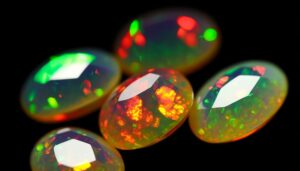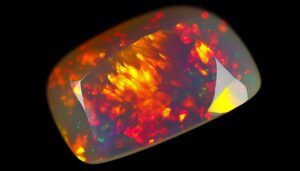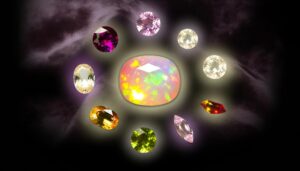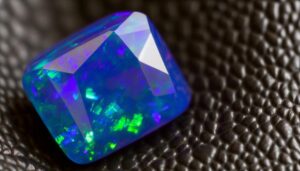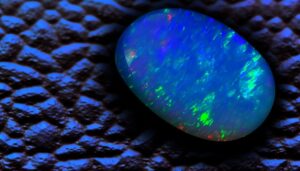What Makes Blue Fire Opal Special?
Blue fire opal is an enchanting gemstone found in volcanic areas of Mexico, Australia, Brazil, and Ethiopia. It primarily consists of hydrated silicon dioxide and features vibrant blue hues thanks to trace elements.
This gemstone's formation involves silica-rich water seeping into volcanic rock cracks, solidifying under specific temperature and pressure conditions. Blue fire opals have a hardness of 5.5 to 6.5 on the Mohs scale, making them somewhat delicate.
Their colors range from electric blue to turquoise, creating a dazzling play-of-color effect. If you explore further, you'll uncover more about its value and uses in jewelry.
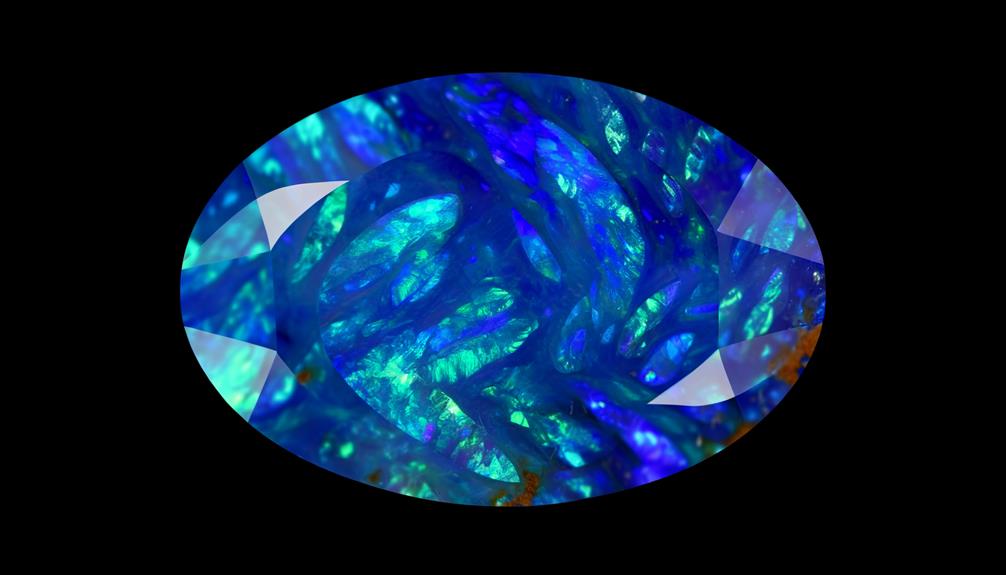
Key Takeaways
- Blue fire opals are gemstones originating from volcanic regions, primarily in Mexico.
- They are composed of hydrated silicon dioxide with trace elements influencing their vibrant blue hues.
- These opals exhibit a range of color variations like electric blue, aqua, indigo, and turquoise.
- Blue fire opals have a hardness of 5.5 to 6.5 on the Mohs scale, requiring careful handling.
- Their value is influenced by factors like color depth, play-of-color, clarity, and geological scarcity.
Origins
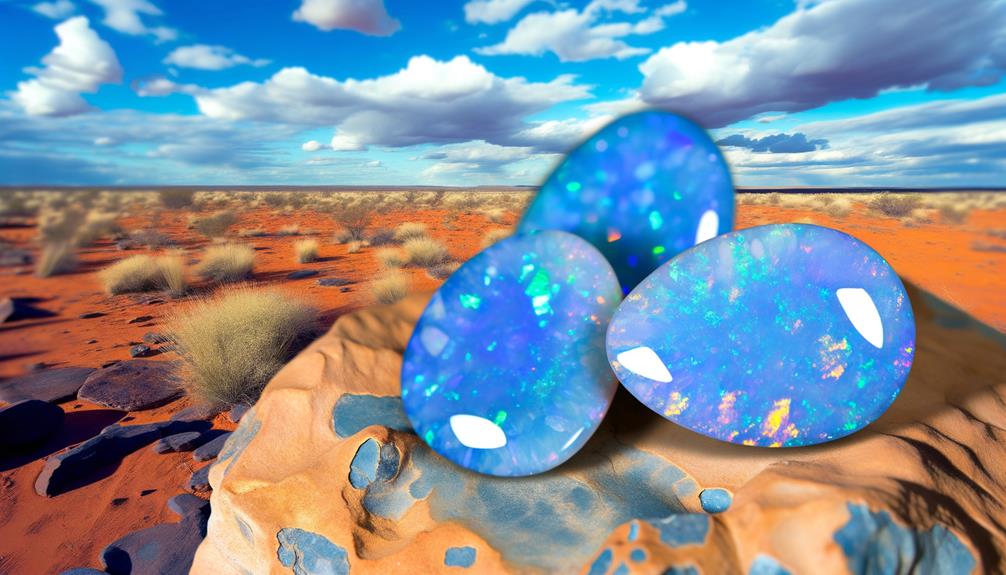
Blue fire opals originate primarily from the volcanic regions of Mexico, characterized by their distinctive play of color due to the diffraction of light within silica spheres. These opals form in rhyolitic lava flows, where silica-rich water percolates through the rock. Over time, this process leads to the creation of microscopic silica spheres arranged in a regular pattern.
When light enters the opal, it diffracts, producing the mesmerizing play-of-color effect. The intensity and variety of colors depend on the size and arrangement of these spheres. Blue fire opals are particularly prized for their vibrant, electric blue hues, which result from specific sphere sizes that interact efficiently with visible light. Understanding their origin helps appreciate their unique beauty.
Geological Formation
You'll explore the geological formation of Blue Fire Opal, focusing on the intricate processes like silica deposition and hydrothermal activity. These opals consist primarily of hydrated silicon dioxide, with trace elements influencing their vibrant blue hue.
You'll also identify key formation locations, including regions in Mexico and Australia.
Geological Processes Involved
In the intricate dance of geological processes, the formation of blue fire opal involves the interplay of silica-rich solutions, precise temperature conditions, and unique environmental pressures over millions of years. When water percolates through the earth, it dissolves silica from sandstone and other rocks. This silica-rich solution seeps into cracks and voids, where it gradually dehydrates and forms a gel-like substance. Over time, under specific temperature and pressure conditions, this gel hardens into opal.
Key factors in this process include:
- Silica saturation: Guarantees sufficient material for opal formation.
- Water evaporation: Drives the solidification of silica gel.
- Pressure fluctuations: Influence the opal's internal structure.
- Temperature stability: Critical for maintaining the integrity of the forming opal.
Understanding these processes reveals the complexity behind blue fire opal's natural beauty.
Mineral Composition Details
Examining the mineral composition of blue fire opal reveals a unique interplay of silica spheres, water content, and trace impurities that give this gemstone its distinctive hue and fire.
The silica spheres, arranged in a precise, orderly pattern, diffract light, creating the opal's characteristic play-of-color. The blue hue specifically results from the presence of water molecules and trace elements such as aluminum, chromium, and titanium. These impurities influence the way light interacts with the silica structure, enhancing the blue coloration.
Additionally, the water content—typically between 3% and 21%—affects the opal's stability and optical properties. By understanding these components, you can appreciate how geological processes craft such a visually striking and scientifically fascinating gemstone.
Formation Locations Worldwide
Blue fire opal forms in specific geological settings, primarily within the volcanic regions of Mexico and the sedimentary deposits of Australia. You'll find these opals in areas where silica-rich water seeps into cracks and voids in volcanic rocks, subsequently solidifying into the stunning blue-hued gemstones.
In Australia, the formation involves sedimentary processes, where silica gel percolates through layers of sandstone and claystone, crystallizing over millions of years.
Key formation locations include:
- Mexico: Volcanic regions, especially in the state of Querétaro.
- Australia: Lightning Ridge, renowned for sedimentary opal deposits.
- Brazil: Notable for its diverse range of opals.
- Ethiopia: Recent discoveries showcase vibrant fire opals.
Understanding these geological formations helps you appreciate the rarity and beauty of blue fire opals.
Physical Properties
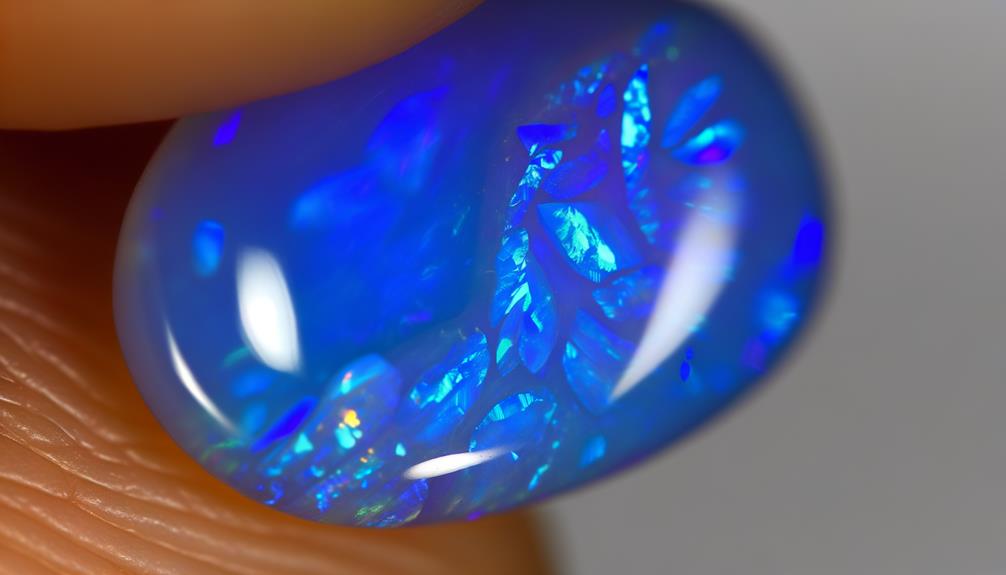
Characterized by its captivating play of color, the blue fire opal showcases a unique combination of transparency and vibrant blue hues, often displaying an iridescent quality under varying light conditions. You'll find that this gemstone's physical properties are as captivating as its appearance. Its hardness ranges from 5.5 to 6.5 on the Mohs scale, making it relatively soft. The specific gravity is between 1.98 and 2.25, indicating a relatively low density compared to other gemstones.
| Property | Value |
|---|---|
| Hardness | 5.5 to 6.5 (Mohs scale) |
| Specific Gravity | 1.98 to 2.25 |
| Transparency | Transparent to translucent |
Handling your blue fire opal with care is essential, as its lower hardness makes it susceptible to scratches and damage.
Color Variations
While its physical properties are remarkable, the blue fire opal truly captivates with its stunning range of color variations. These variations are due to the interplay of light with the internal structure of the opal, which causes diffraction and results in a spectrum of colors. The primary hue is blue, but you'll often observe flashes of other colors due to the play-of-color phenomenon.
Key color variations include:
- Electric Blue: A vibrant, almost neon blue.
- Aqua: A softer, oceanic blue that evokes tranquility.
- Indigo: A deep blue with purple undertones.
- Turquoise: A greenish-blue reminiscent of tropical waters.
Understanding these variations helps you appreciate the unique beauty and complexity of blue fire opals, making them a treasured addition to any collection.
Key Differences
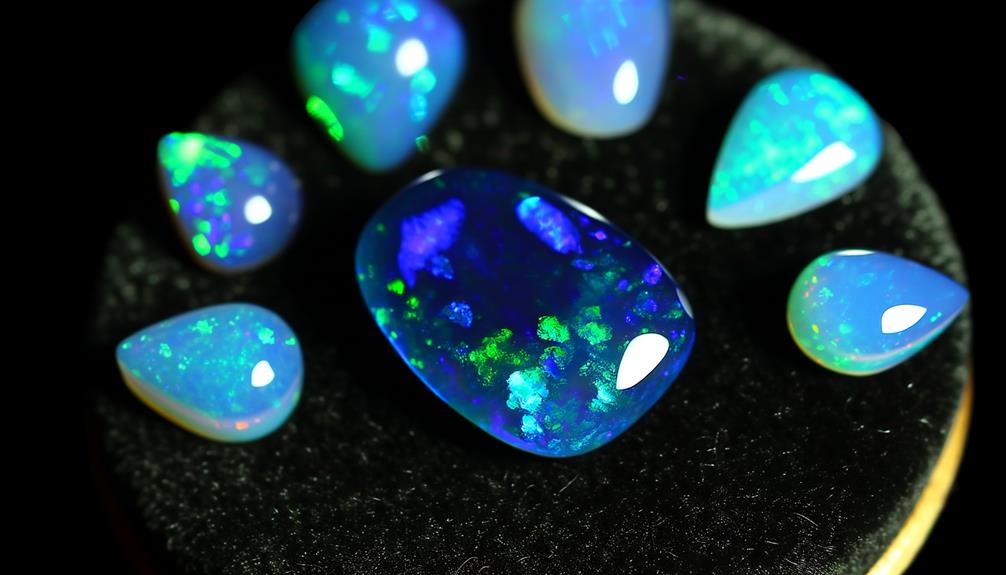
You should focus on the key differences of Blue Fire Opal by examining its:
- Color and appearance
- Formation and origin
- Value and rarity
Each aspect highlights unique characteristics that set Blue Fire Opal apart from other gemstones. Understanding these distinctions will give you a thorough perspective on what makes this gem distinctive.
Color and Appearance
The color and appearance of blue fire opal differ noticeably from other opals due to its unique play-of-color and vibrant blue hues. You'll observe that blue fire opals display a spectrum of blue shades, from deep indigo to light azure, which isn't common in other opal varieties.
The interplay of light within the opal creates a mesmerizing effect, known as opalescence, enhancing its appeal.
Key features include:
- Play-of-Color: Multicolored light flashes within the stone.
- Transparency: Ranges from translucent to opaque.
- Body Tone: Primarily blue, often with green or purple overtones.
- Brilliance: High degree of light reflection, adding to its vividness.
These characteristics make blue fire opal distinct and highly sought after by gemstone enthusiasts.
Formation and Origin
Understanding the formation and origin of blue fire opal reveals the geological processes that contribute to its unique characteristics. Blue fire opal forms in silica-rich, volcanic environments. As water percolates through silica deposits, it carries dissolved silica into underground cavities and fissures. Over time, the silica gel solidifies, creating opal.
The blue color arises from trace elements like copper and iron, which interact with the silica structure. Additionally, the diffraction of light through uniform silica spheres results in the opal's vibrant play-of-color. Unlike other opals, blue fire opals often form in rhyolitic volcanic rock, which provides the ideal conditions for their formation.
Understanding these complex processes allows you to appreciate the geological marvel that blue fire opal represents.
Value and Rarity
Blue fire opal's value and rarity are greatly influenced by its distinctive color, play-of-color, and geological scarcity.
You'll find that the intensity and consistency of the blue hue can notably elevate its market value. Additionally, the presence of a vibrant play-of-color, where light diffracts to exhibit a range of colors, is a key determinant of its worth.
Geological scarcity also plays a pivotal role; these opals are typically found in limited regions, making them rare and highly sought after.
- Color Depth: Deeper blue tones command higher prices.
- Play-of-Color: Bright spectral displays enhance value.
- Geological Scarcity: Limited mining locations boost rarity.
- Clarity: Fewer inclusions lead to higher valuation.
Understanding these factors helps you appreciate the uniqueness of blue fire opals.
Popular Sources
Australia, Ethiopia, and Brazil rank among the most popular sources of blue fire opal. Each country offers distinct geological conditions that contribute to the gem's unique properties.
In Australia, opals form in sedimentary rock layers rich in silica, facilitating the creation of vibrant play-of-color. Ethiopian blue fire opals are typically found in volcanic ash deposits, which provide a different mineral composition that enhances the stone's iridescence.
Brazil's opal deposits, located primarily in the Piauí region, result from hydrothermal processes within basalt formations. These processes contribute to the gem's clarity and vivid hue.
Each location's unique geological environment influences the opal's structural integrity, color intensity, and overall quality. It is essential to understand these factors when sourcing blue fire opals.
Market Value
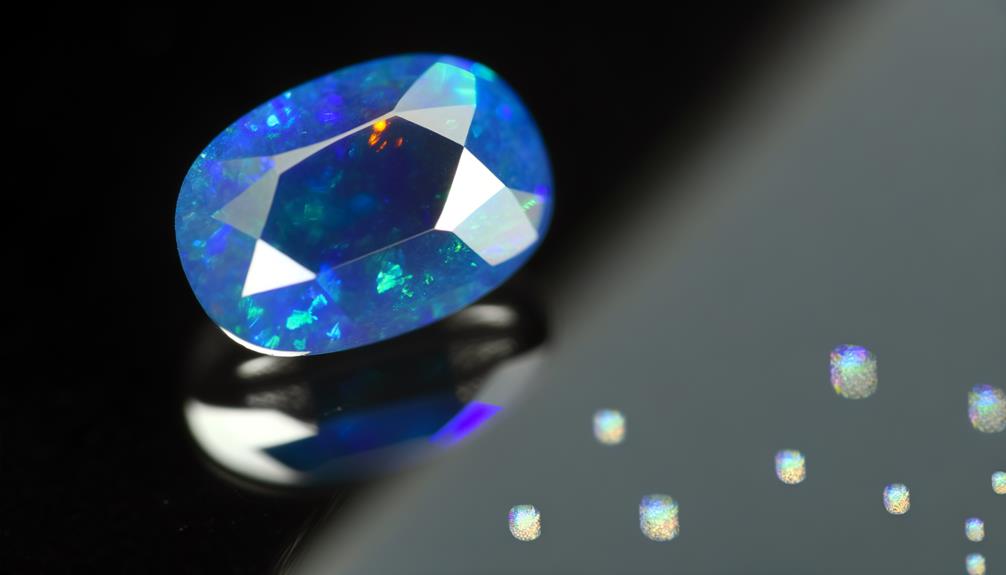
Given the distinct geological conditions that influence blue fire opal's characteristics, the market value of these gems can vary greatly based on factors such as origin, clarity, and color intensity.
You'll find that blue fire opals from reputable locations like Australia or Mexico typically command higher prices.
The clarity of the stone, meaning its transparency and lack of inclusions, also plays a significant role in valuation.
Color intensity, where deeper and more vivid hues are more sought-after, further impacts the price.
Factors impacting market value include:
- Origin: Provenance from renowned sources like Australia or Mexico.
- Clarity: Transparency and minimal inclusions.
- Color Intensity: Depth and vividness of blue hues.
- Cut: Precision and quality of the gemstone's cut.
Understanding these aspects will help you better assess a blue fire opal's worth.
Uses in Jewelry
You'll find Blue Fire Opal's unique aesthetic appeal makes it a standout choice for various jewelry pieces.
Its versatile design options allow it to be set in rings, necklaces, and earrings, enhancing both contemporary and traditional styles.
Additionally, its symbolic meanings and current trends contribute to its popularity in the jewelry market.
Unique Aesthetic Appeal
When set in jewelry, blue fire opals captivate with their striking play-of-color, characterized by vibrant flashes of blue and green against a translucent to opaque background. These opals' unique aesthetic appeal stems from their internal structure, which diffracts light to create mesmerizing color shifts.
You'll find them particularly enchanting in various types of jewelry due to their:
- High refractive index: Enhances brilliance and sparkle.
- Hydrophane nature: Absorbs water, altering transparency and play-of-color.
- Silica-based composition: Provides durability and varied color patterns.
- Unique crystal lattice: Produces individualized, non-replicable flashes.
Versatile Design Options
The unique aesthetic appeal of blue fire opals makes them ideal for a wide range of versatile design options in jewelry, from intricate pendants to elegant rings. Their vibrant play-of-color and translucency allow you to create stunning focal points in any piece.
When set in a prong or bezel setting, the gemstone's optical properties are maximized, enhancing its iridescence. You can incorporate blue fire opals into various metal types, including platinum, gold, and sterling silver, each complementing the opal's unique hues.
Additionally, they're perfect for custom designs, enabling you to craft personalized pieces that resonate with your style. Whether used as centerpieces or accent stones, blue fire opals offer a scientifically fascinating and visually enthralling element.
Symbolic Meanings and Trends
Blue fire opals, celebrated for their mesmerizing play-of-color, not only enhance jewelry designs but also embody profound symbolic meanings and current trends in the gemstone market. When you incorporate blue fire opals into your jewelry, you're tapping into a rich tradition of symbolism and modern appeal.
- Symbolic Meanings: Blue fire opals are often associated with emotional healing, creativity, and inspiration.
- Popularity in Jewelry: These opals are trending in rings, pendants, and earrings due to their vibrant hues and unique patterns.
- Metaphysical Properties: Believers assert that blue fire opals enhance intuition and personal insight.
- Market Trends: Demand for ethically sourced blue fire opals is rising, reflecting a broader consumer preference for sustainable gemstones.
Care Tips
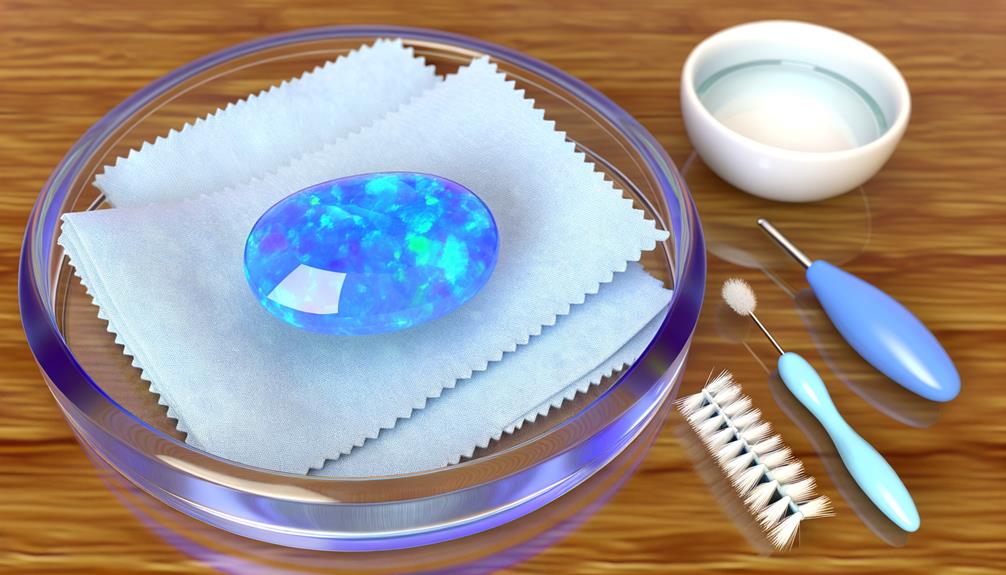
To maintain the brilliance and durability of your blue fire opal, consistently clean it with a soft, damp cloth and avoid exposing it to harsh chemicals or extreme temperature fluctuations.
Blue fire opals are hydrophane opals, meaning they can absorb water and other liquids, potentially altering their color and clarity. Store your opal in a dry, stable environment, and keep it away from direct sunlight to prevent dehydration and cracking.
When wearing your opal, avoid activities that could cause physical stress or abrasion to the stone. Periodically check the setting for any signs of wear or loosening.
Buying Guide
When purchasing a blue fire opal, prioritize examining its play-of-color, transparency, and absence of inclusions to ensure you're acquiring a high-quality specimen.
The gem's play-of-color should exhibit vibrant, multi-directional flashes. Verify the opal is transparent or semi-transparent, as this enhances its visual appeal.
Inclusions, such as cracks or foreign materials, can compromise the gem's integrity and value, so select specimens that are free from these imperfections.
Additionally, consider the opal's cut and polish, which greatly influence its brilliance and durability.
- Play-of-color: Look for vivid, multi-directional flashes.
- Transparency: Opt for transparent or semi-transparent stones.
- Inclusions: Avoid opals with cracks or foreign materials.
- Cut and Polish: Assess the gem's finish for brilliance and durability.
Interesting Facts
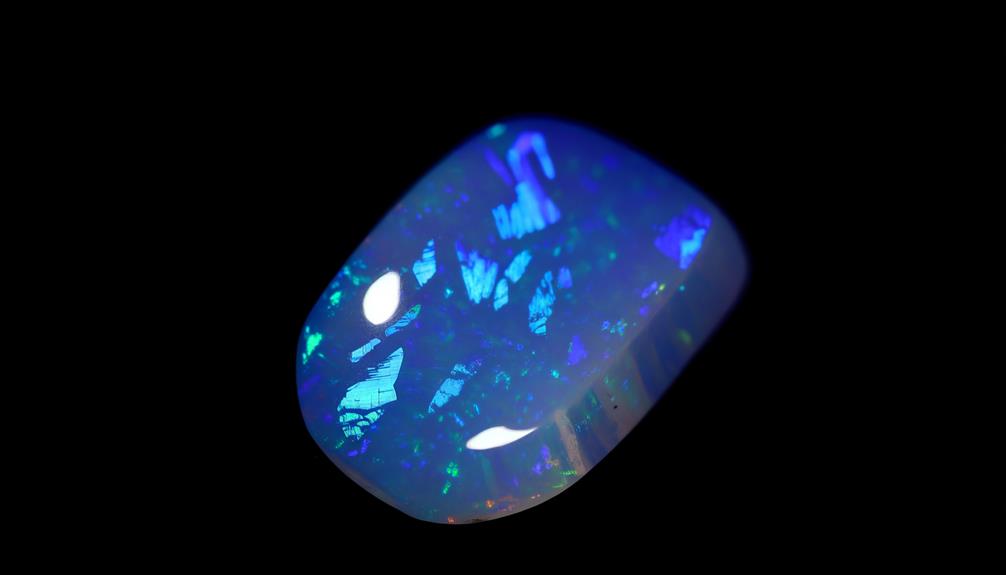
While selecting a high-quality blue fire opal is essential, it's equally fascinating to explore how these gemstones form through a unique combination of silica deposits and water over millions of years.
Silica-rich solutions percolate through rock layers, depositing microscopic spheres of silica in cavities. As water evaporates, these spheres stack in an orderly array, creating diffraction of light, which results in the opal's vibrant play-of-color.
Interestingly, the blue fire opal's radiant hue arises from the specific size and arrangement of these silica spheres. Smaller spheres tend to produce blue and green colors due to shorter wavelengths of light being diffracted. Understanding this intricate process not only enhances your appreciation but also informs your selection of these mesmerizing gems.
Conclusion
To sum up, blue fire opal's distinctive beginnings, lively color changes, and breathtaking physical characteristics make it an outstanding option for jewelry.
You may have concerns about its fragile quality, but by taking good care of it—steering clear of extreme temperatures and strong chemicals—it will stay dazzling.
The particular geological creation of this gemstone and its scarcity contribute to its charm.
When purchasing blue fire opal, you're not simply obtaining a gemstone; you're gaining a piece of Earth's captivating natural history.

